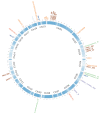Advanced Breeding for Biotic Stress Resistance in Poplar
- PMID: 35956510
- PMCID: PMC9370193
- DOI: 10.3390/plants11152032
Advanced Breeding for Biotic Stress Resistance in Poplar
Abstract
Poplar is one of the most important forest trees because of its high economic value. Thanks to the fast-growing rate, easy vegetative propagation and transformation, and availability of genomic resources, poplar has been considered the model species for forest genetics, genomics, and breeding. Being a field-growing tree, poplar is exposed to environmental threats, including biotic stresses that are becoming more intense and diffused because of global warming. Current poplar farming is mainly based on monocultures of a few elite clones and the expensive and long-term conventional breeding programmes of perennial tree species cannot face current climate-change challenges. Consequently, new tools and methods are necessary to reduce the limits of traditional breeding related to the long generation time and to discover new sources of resistance. Recent advances in genomics, marker-assisted selection, genomic prediction, and genome editing offer powerful tools to efficiently exploit the Populus genetic diversity and allow enabling molecular breeding to support accurate early selection, increasing the efficiency, and reducing the time and costs of poplar breeding, that, in turn, will improve our capacity to face or prevent the emergence of new diseases or pests.
Keywords: QTL; biotic stress; breeding; climate change; genome editing; poplar; resistance.
Conflict of interest statement
The authors declare no conflict of interest.
Figures


References
-
- Eckenwalder J.E. Systematics and Evolution of of Populus. In: Stettler R.F., Bradshaw H.D.J., Heilman P.E., Hinckley T.M., editors. Biology of Populus and Its Implications for Management and Conservation. NRC Research Press; Ottawa, ON, Canada: 1996. pp. 7–32. Chapter 1.
-
- Lin Y.C., Wang J., Delhomme N., Schiffthaler B., Sundström G., Zuccolo A., Nystedt B., Hvidsten T.R., de la Torre A., Cossu R.M., et al. Functional and evolutionary genomic inferences in Populus through genome and population sequencing of American and European aspen. Proc. Natl. Acad. Sci. USA. 2018;115:E10970–E10978. doi: 10.1073/pnas.1801437115. - DOI - PMC - PubMed
-
- Mohrdiek O. Future possibilities for poplar breeding. Can. J. For. Res. 1983;13:465–471. doi: 10.1139/x83-070. - DOI
Publication types
Grants and funding
LinkOut - more resources
Full Text Sources

